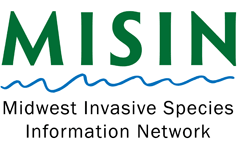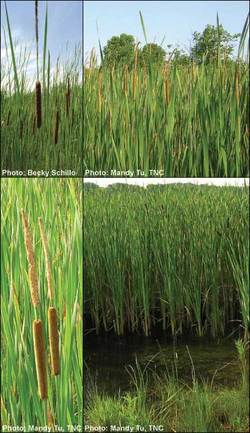|
Narrow leaf cattail (Typha angustifolia)
Scientists are not yet sure whether narrow-leaf cattail was introduced from Europe, or whether it was already present in the US along the Eastern seaboard, from which it would have moved westward with European settlers along newly developed corridors like railroads and roadways. It was first recorded in Michigan in 1837.
What problems does it cause? Like most invasive plants, narrow-leaf cattail forms monocultures that replace native plants in high quality natural areas, which in turn reduces critical food resources for birds, butterflies, and other wild creatures. Recent genetic sampling of cattail indicated that the National Lakeshores at Sleeping Bear Dunes and Pictured Rocks are the only national parks in the Midwest with healthy native cattail populations. Cattail populations in Voyageurs National Park, St. Croix National Park, and Indiana Dunes National Lakeshore were nearly 100% invasive T. angustifolia and T. x glauca. What does invasive cattail look like? Narrow-leaf cattail’s leaves are about ½ inch wide, roughly half the width of the native broadleaf cattail (Typha latifolia). There is also a gap of one to three inches between the male and female flowering parts. The two species also hybridize, producing a cross called Typha x glauca that can exhibit characteristics of both species, though is often taller and more aggressive than either parent species. How do I manage invasive cattail? Management options abound for cattail. Visit the Midwest Invasive Plant Network’s (MIPN) control database (http://mipncontroldatabase.wisc.edu/) to explore options like mowing, digging, grazing, water level manipulation, and chemical control. In all cases long-term success in habitat management depends on thorough knowledge of the environment and the invasive species present. Be sure to survey the site and develop a management plan before embarking on control efforts. As a part of your management plan, be sure to consider sources of disturbance as well as vectors for entry of invasive cattails. Often pollutants that encourage invasive cattail monocultures enter wetlands via stormwater flows from nearby urban areas, a problem that can be addressed in part through rain gardens and other low-impact development tools. |
|
| habitatmatters.org |
Contact US231-252-4148
3334 Veterans Drive Unit A Traverse City, Michigan 49685 |
Pleasant Peninsula Design, Habitat Matters 2017



